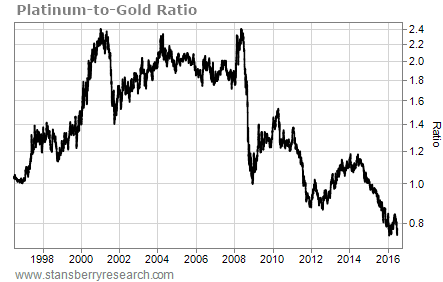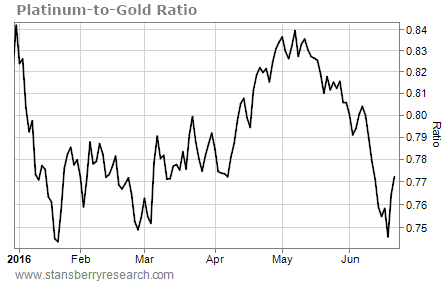Many of the world’s greatest investors look for a “trigger” before they make an investment.
As legendary global investor Jim Rogers famously said…
I just wait until there is money lying in the corner, and all I have to do is go over there and pick it up. I do nothing in the meantime.
In 1998, Rogers bought more than 30 different commodities. He believed they were hated and selling at rock-bottom prices.
[ad#Google Adsense 336×280-IA]Most increased by multiples of his purchase price.
One of these – gold – averaged $296 an ounce in 1998.
By 2011, it peaked at $1,900 per ounce.
Today, we have an opportunity like this in platinum…
You see, platinum hit a multidecade low relative to gold earlier this year.
But it has started to take a few steps toward a reversal of the ratio’s trend over the past eight years.
The average platinum-to-gold ratio has been 1.47 over the past 20 years. As you can see in the chart below, the ratio sits at 0.77 today. From 1990 to 2015, it never fell that low.
That means, on average, an ounce of platinum has been 47% more expensive than an ounce of gold in that span… But today, you can buy an ounce of platinum at a 23% discount to an ounce of gold.
 Over the past two decades, platinum has traded at a higher price than gold 86% of the time. Platinum normally trades for more than the price of gold. And it will again. That’s mainly because it’s harder to find than gold. In 2015, China and Australia each produced more gold ounces than the total global production of platinum.
Over the past two decades, platinum has traded at a higher price than gold 86% of the time. Platinum normally trades for more than the price of gold. And it will again. That’s mainly because it’s harder to find than gold. In 2015, China and Australia each produced more gold ounces than the total global production of platinum.
Historical relationships like this tend to “revert to the mean.” That simply means they often return to average levels.
Regular Growth Stock Wire readers will recall a similar situation recently with the relationship between gold and silver. In March, the gold-to-silver ratio reached a level it had only seen four times (including this one) over the past 20 years.
Today, the gold-to-silver ratio has fallen from its recent high of 83 to less than 74 in just more than four months. That means silver outperformed gold by 11% over this period… and that’s in spite of the 3% increase in the gold price during that span. If you had just bought silver and not gold, you would have made more than 16%.
And if you look at platinum’s year-to-date chart, you can see it just started a new run…
 You might notice that platinum tried to outperform gold after its January bottom, too, when it closed the gap from about 0.74 to 0.84 in May.
You might notice that platinum tried to outperform gold after its January bottom, too, when it closed the gap from about 0.74 to 0.84 in May.
But the strong rise in the price of gold cut short platinum’s run. Gold has doubled platinum’s move this year. It’s up 20% in 2016, compared with platinum’s 10%.
There’s one key difference today, though… And that’s the trigger investors need. Some experts believe gold has reached at least a short-term top.
Earlier this week, Bill Bonner – founder of the Agora network that includes Stansberry Research – said he believes gold is accurately priced at its current level. I can’t tell you if the gold price has peaked for the moment… But if it has, any appreciation in the platinum price today would continue to narrow the ratio.
Plus, there’s another factor working in our favor. Even if gold doesn’t level off right now, the numbers work to our advantage.
You see, the platinum industry has been producing less of the metal than consumers have been buying for several years now. Demand has regularly outpaced supply. From 2013 to 2015, the average deficit stood at 578,000 ounces.
The World Platinum Investment Council expects that trend to continue. It’s forecasting another 455,000-ounce deficit this year. Industry analyst Johnson Matthey expects a larger shortfall of about 860,000 ounces.
Regardless of the number, the point remains the same… Miners will come up short.
The continuing deficits mean the above-ground inventories of the metal continue to fall. They’ve dropped by more than 50% since 2012. At this pace, there won’t be any excess platinum left in as little as three years. If that happens, watch out.
Recent events in the platinum world could make it happen sooner than you might think.
Earlier this month, competing unions at Northam Platinum’s Zondereinde mine in South Africa clashed. The fights resulted in the death of a member of each union. Northam halted operations at the mine for 10 days while emotions cooled. The government had to intervene to encourage employees to return to work.
This mine provides more than 5% of global platinum production. The 10-day halt alone removed nearly 3% of the company’s annual output.
And in Zimbabwe, the government plans to acquire (or seize) nearly 70,000 acres of land within the license area of Impala Platinum’s subsidiary in the country. The company accounts for more than half of Zimbabwe’s 400,000 ounces of annual platinum production. The matter remains unsettled, but any loss of land is likely to lead to further erosion in ounces of platinum produced.
These events aren’t lost on the market. Platinum has begun to appreciate versus gold. It’s a trend worth following.
The most straightforward way to participate in the coming platinum uptrend is to buy the metal itself. But you can also profit with one Canadian company that has recently started operating a new platinum mine in South Africa.
Platinum Group Metals (PLG) started building its Maseve mine in 2011. Earlier this year, it began operations and is currently ramping up production at the mine.
It’s a great way for you to put your money to work in platinum today.
Good investing,
Brian Weepie
[ad#stansberry-ps]
Source: Growth Stock Wire

